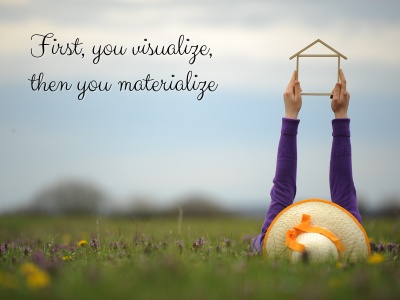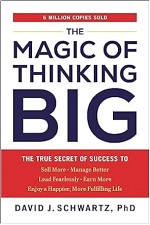Last updated on October 13th, 2023 at 01:26 pm
 When I set a vision to paper, my soul can finally take a break from obsessing over it. It’s the one great thing about the process of writing down your dreams or creating a vision board.
When I set a vision to paper, my soul can finally take a break from obsessing over it. It’s the one great thing about the process of writing down your dreams or creating a vision board.
Once you remove something from your head and put it on paper, it generates a sacred space for its creation. It then allows your soul to work on ways to make your vision appear in your life. You have actually created something with the simple process of putting your vision on paper.
I might even argue that collecting images of your dream on Pinterest (truly seeing yourself in those images) and sharing them with others is as powerful a visionary tool as writing it down or drawing a picture.
Whatever gets your vision going, baby.
And out of your head.
It’s intriguing to be an observer in your own life, to witness the moment your vision takes form as soon as it exits the confines of your mind. Have you ever contemplated the concept of paying attention to what unfolds rather than busying yourself and pretending not to notice?
When you release your vision into the world, it has a ripple effect. Your external world either needs to make space for the creation you’re about to birth, or it may offer some instructive experiences to prepare you for your vision’s realization in the real world, and, in some cases, it might do both simultaneously. Simultaneity is often the most challenging. It might feel like you’re navigating a tempest within a whirlwind.
Many individuals disembark from their big dream journey when the hurricane ride intensifies. It’s a pivotal moment, the grave error of quitting. They fail to perceive that the turbulence is a sign of a new life emerging, of transformation sweeping through their existence, guiding them along the path of life. It can be surprising where this journey leads them, often precisely where they aspired to be.
But here’s a little secret for coping with the upheaval necessary for accommodating your dream vision: the pain and fear dissipate when you swiftly seek the lessons and perhaps add “as painlessly as possible” to your affirmations for good measure. Acknowledge what’s happening and reassure yourself that you can land on your feet.
This may well become your finest hour.
You might even find the courage to instigate change and create space on your terms rather than waiting for the universe to do it for you, even if the prospect of change terrifies you. Since I put my vision on paper, my dream-filled week has revolved around embracing change and the universe reshaping my life. You’d think I’d be content about it, but…
BAM! There it is. It’s not the change I initiated.
It’s change thrust upon me, and it’s not the type of change I desired. I’m apprehensive about what lies on the other side, anxious about landing on my feet. This change is delivered as a lesson. The lesson is learning to let go gracefully.
Releasing certain aspects of my life is a challenge. I struggle with it. I excel at decluttering but often cling to habits, jobs, relationships, and undergarments longer than I should. It provides a semblance of security or gives the illusion of security. The sooner I embrace the lesson, the better I can handle the impending storm. I hope to emerge on the other side as a more resilient, improved version of myself, one step closer to realizing my extraordinary dream.
Similar to when I welcomed my first (and only) child. That dream-come-true experience has been the highlight of my life. I envisioned him long before his arrival. I had to grapple with loss and create room for change in my life to make space for my son. Parenthood comes with sacrifices, including freedom (and sleep), not to mention financial strain. However, if you allow it, parenthood can transform you into a better person as your life changes significantly.
It’s accepting change–the visionary’s curse.
Sometimes, the changes that manifest can be excruciating, but when this occurs, the universe eventually offers something beautiful in return if you’re willing to let go. I lost my father at age 18 and gained a son at age 35. If I had to choose between the two remarkable men, despite my love for my father, I’d always opt for my son. My life is enriched by having one of the two great men.
I received a magnificent gift in exchange for my sacrifice and pain.
Don’t fear putting your dreams on paper and sharing them with the world. Accept that change will arrive, and understand that as you open the doors to the winds of change, countless possibilities are racing toward you.
How to Write Your Dream Vision Down
So, how do you go about writing down your dream vision? Here’s a simple guide to get you started:
1. Clear Your Mind: Find a quiet, comfortable space where you won’t be disturbed. Take a few moments to clear your mind and focus on your vision. What is it that you want to achieve or create? Let your mind wander and dream.
2. Start with a Vision Statement: Write a concise and clear vision statement encapsulating your dream. This powerful sentence should capture the essence of what you want to achieve. Keep it positive and in the present tense, as if it’s already happening.
3. Break It Down: Break your vision into smaller, actionable goals or steps. These should be specific and measurable, making it easier to track your progress.
4. Create a Vision Board: Collecting images that resonate with your dream can be a powerful tool. Create a vision board with these images to keep your vision alive daily.
5. Write a Letter to Yourself: Imagine you’ve already achieved your dream. Write a letter to your future self expressing gratitude and joy for realizing your vision. This can be a powerful motivational tool.
6. Set a Timeline: Determine a timeline for when you’d like to see your dream come to life. These could be short-term and long-term goals. Having a timeline will keep you accountable and motivated.
And if you are questioning whether visioning works or not, think about this story about the actor and comedian Jim Carrey:
In the early 1990s, before Jim Carrey became a household name in the world of comedy and acting, he was a struggling and relatively unknown actor. He tried to make a name for himself in Hollywood but faced numerous rejections and challenges.
Jim Carrey lived in Los Angeles and dreamed of becoming a successful and highly-paid actor. To motivate himself and manifest his dream, he wrote himself a check for $10 million for “acting services rendered” and dated it for five years in the future. He kept the check in his wallet to constantly remind him of his goal.
Carrey also began visualizing his success. He would take long drives at night up into the Hollywood Hills, and while looking at the city lights below, he’d envision himself as a successful actor with directors and producers interested in his work. He would visualize receiving scripts, getting cast in major roles, and enjoying his newfound success.
Jim Carrey’s perseverance, belief in himself, and unwavering focus eventually paid off. In 1994, just before the date on the check, he received a movie role in “Dumb and Dumber” that earned him $10 million, which was a significant breakthrough in his career. This success marked the realization of the check he had written to himself five years earlier.
Carrey has shared his story as a testament to the power of visualization, setting intentions, and believing in one’s dreams. His journey from a struggling, aspiring actor to a Hollywood superstar is often cited as an inspirational example of what can be achieved through determination and a positive mindset.
In essence, whatever sets your vision into motion is valid.
 |  |  |

Catherine Hughes is an accomplished magazine columnist, content creator, and published writer with a background as an award-winning mom blogger. She partners with companies to create captivating web content and social media stories and writes compelling human interest pieces for both small and large print publications. Her writing, which celebrates the resilience and achievements of Northern California’s residents, is featured in several magazines. Beyond her professional life, Catherine is passionate about motherhood, her son, close friendships, rugby, and her love for animals.
Note: Articles by Catherine may contain affiliate links and may be compensated if you make a purchase after clicking on an affiliate link.




